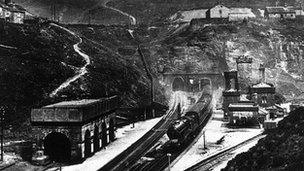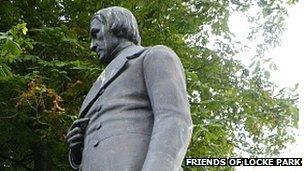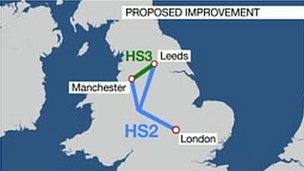The North tunnelling to prosperity with HS3?
- Published
- comments

The first HS3? Postcard of Woodhead Tunnel held in Thameside Archive
It is a simple idea aimed at boosting the economy of the North.
Dig an expensive tunnel under the Pennines and run lots of high-speed trains through it carrying commuters and goods between Yorkshire and Lancashire.
On a recent trip taking in both Manchester and Leeds, the Chancellor George Osborne said he thought it was an economic gamble worth taking.
But then, so did Joseph Locke.
Technological marvel
Locke was the engineer who completed the first railway tunnel under the Pennines as long ago as 1845.
History has not immortalised his name in the same way as his much more famous contemporaries George Stephenson and Isambard Kingdom Brunel, but Locke's railways were a significant force in turning 19th Century Britain into an industrial powerhouse.

Joseph Locke statue in the Barnsley Park named in his honour
He is still celebrated in his home town of Barnsley where his statue can be found in the local park created in his name from land donated by his widow Phoebe.
It took six years and the lives of 32 "navvies" to blast and pick axe through over three miles of granite but by the time of its completion the Woodhead Tunnel was one of the longest in the world and a technological marvel.
So many steam trains thundered through it that a second tunnel was completed a couple of years later.
In fact, even as late as the 1950s, that Trans-Pennine rail link between Sheffield and Manchester was considered to be so important that a much wider third tunnel was added to take one of the country's first electrified railways.
Last train
By the 1970s rail was becoming of such secondary importance to roads that the last train went through in 1981.
Today, only huge electric cables from the National Grid run through any of those tunnels.
A little further south, the 130-year-old Hope Valley line through the Peak District National Park still operates but its capacity is much smaller.
Most trans-Pennine rail traffic is now along the ageing main lines between Leeds and Manchester.
With queues of traffic now frequently clogging the M62 motorway across the Pennines, transport thinking has now turned full circle with better rail links now seen as the way to boost business across the North.
As long ago as 2008, research carried out for the then Regional Development Agencies of The North West and Yorkshire concluded that if the Leeds to Manchester line could improve speed and capacity by just 20% then the benefits to the economy would be worth well over £6bn a year.
Now a new report called "One North" has been published by the clusters of local councils making up the North's "City Regions" which puts a new high speed line with 125mph line at the top of a £15bn wish list of road and rail improvements.
HS3 Link

HS3 rail link-linking up the two arms of HS2
The idea, which some are calling HS3, would see the two branches of the promised £43bn HS2 railways from London scheduled to reach Leeds and Manchester by 2032.
It has brought a wry smile from campaigners who spent years trying to have the track re-laid through the Woodhead Tunnel but have been told it is no longer up to the job by by successive transport ministers.
There has also been a mixed reception.
Huddersfield University transport expert Professor Paul Salveson, in the latest edition of his aptly named blog the Salvo, writes of the HS3 proposal: "Bring it on".
He says it could go some way to answering his original objections that HS2 was a 'London-centric configuration with dead-end termini at Leeds and Manchester, served by trains that can only go on the high-speed line".
But others say the money would be best spent upgrading what we already have.
So the arguments that confronted engineers like Joseph Locke over 180 years ago are now being repeated. Is it a practical investment that will benefit us all or just a publicity seeking vanity project for just those who will be able to afford what are likely to be expensive tickets?